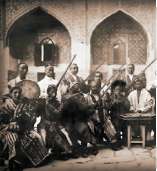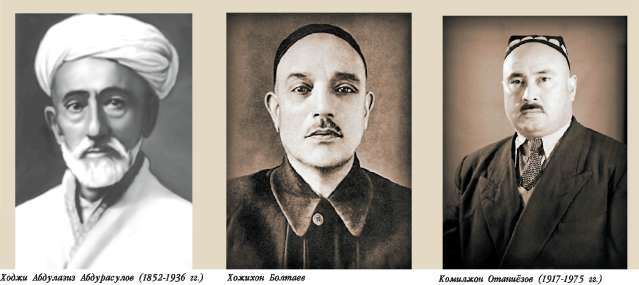 Uzbek musical classics is priceless in its of significance. Works, created on the basis of the Uzbek epic tales – people’s boys and their melodies, occupy a solid place in the classical music in the repertoire of Khafizov, bakhshi. The song “Naylayin” (“what should I do?”), written by people’s artist of Uzbekistan and Karakalpakstan Turkmenistana Kamiljanom Ataniyazopvim is one of them. In her the basis of paintings excerpt from the epos “Oshik; Garib and Schoch,Sanam” (“Love Garib and the Shahsanam”), where the sad Shahsanam tells his court maid – faithful assistant Акче of parting with favorite – Garibom, which Shah Abbas condemned to exile. The style of the directions of music – “zorinji” (UZB. – “zorlanuvchi” – setuyuschy on their fate). In the Khorezm dastans every song has a name – “nome” – musical compositions range from fifth octave the volume of the – si-flat of the great octave to the notes prior to the second octave, which are preceded by a special verbal text, determining their content. The songs are very different the size and composed independently of the author or borrowed them from history, folk tales, any artistic works, etc. Name suggests their table of contents (for example, “farewell”, “the complaint”, “groan”, etc.). To. OJSC Ataniyazov, deeply feel the content of the passage of epos, written in силлабическом amount, wrote the music to the him. The melody, the strength of the sound, the range and technical the possibility of a national instrument, dutar, fused together with voice, created щедевр. Work-the song “Guluzorim” (“the Flower of my”), composed Khodja Abdulaziz Abdurasulov, singer and bastakor (composer for the same instrument and одноголосого execution and for many tools and многоголосого singing). Facts, confirming his trip to Khorezm, no, but some written archival sources confirm its frequent communication with хорезмскими хафизами (folk singers). I think, the impetus to create the song “Guluzorim” has become an art Khorezm singers. X. Abdurasulov of “Shashmakom” took and skillfully used the places with the sudden transition to the top register “Авжи Turk”. Prologue – the introductory part of the song “Guluzorim” – a synthesis of melodies “Kurt Eshvoy” and Shashmakom.
Uzbek musical classics is priceless in its of significance. Works, created on the basis of the Uzbek epic tales – people’s boys and their melodies, occupy a solid place in the classical music in the repertoire of Khafizov, bakhshi. The song “Naylayin” (“what should I do?”), written by people’s artist of Uzbekistan and Karakalpakstan Turkmenistana Kamiljanom Ataniyazopvim is one of them. In her the basis of paintings excerpt from the epos “Oshik; Garib and Schoch,Sanam” (“Love Garib and the Shahsanam”), where the sad Shahsanam tells his court maid – faithful assistant Акче of parting with favorite – Garibom, which Shah Abbas condemned to exile. The style of the directions of music – “zorinji” (UZB. – “zorlanuvchi” – setuyuschy on their fate). In the Khorezm dastans every song has a name – “nome” – musical compositions range from fifth octave the volume of the – si-flat of the great octave to the notes prior to the second octave, which are preceded by a special verbal text, determining their content. The songs are very different the size and composed independently of the author or borrowed them from history, folk tales, any artistic works, etc. Name suggests their table of contents (for example, “farewell”, “the complaint”, “groan”, etc.). To. OJSC Ataniyazov, deeply feel the content of the passage of epos, written in силлабическом amount, wrote the music to the him. The melody, the strength of the sound, the range and technical the possibility of a national instrument, dutar, fused together with voice, created щедевр. Work-the song “Guluzorim” (“the Flower of my”), composed Khodja Abdulaziz Abdurasulov, singer and bastakor (composer for the same instrument and одноголосого execution and for many tools and многоголосого singing). Facts, confirming his trip to Khorezm, no, but some written archival sources confirm its frequent communication with хорезмскими хафизами (folk singers). I think, the impetus to create the song “Guluzorim” has become an art Khorezm singers. X. Abdurasulov of “Shashmakom” took and skillfully used the places with the sudden transition to the top register “Авжи Turk”. Prologue – the introductory part of the song “Guluzorim” – a synthesis of melodies “Kurt Eshvoy” and Shashmakom. 
Eshvoy bakhshi (the narrator, folk singer) was a native of Khorezm Shavat was. The heyday of his work falls on the the reign of Alla-Kuli Khan (1825 – 1842 gg.). Among many educated them disciples of the most gifted and known was Matniyaz гуржа – blind in both eyes, so Turkmens to his name added the console-proizvische Gurzhi. Karakalpaks know him as Garibniyaz. Matniyaz wrote poems about his mentor Эшвое bakhshi, and then composed the music for the band. In the song celebrate its origin, wittiness, the best human qualities:
 In his time, competing with the Otash and Нурхон bakhshi in eloquence and the art of singing. He composed the melodies, tunes (noma) to the дастанам, which performed himself. Up to us got it a few works, in particular, for recitative performance – syllabic version of the epos “Eshvoy”, again rhymed them eleven slot verse. For execution of an instrumental version of preserved such his works as “Eshvoy Urganzhy” and “Turkman Eshvoyи”. “Kurt Eshvoyи” is known as ашула. The people Эшвоя name Kurt – the name of the Holy grandparent ancient the Turks of the Storm-Кашкир (UZB. “the storm” – a she-wolf). The song is named for the name and the nickname of the Creator. In the Ferghana valley is the same product of, harmonies and musical structure which of the same type, but the content and the structure of poems differ into force of local influences.
In his time, competing with the Otash and Нурхон bakhshi in eloquence and the art of singing. He composed the melodies, tunes (noma) to the дастанам, which performed himself. Up to us got it a few works, in particular, for recitative performance – syllabic version of the epos “Eshvoy”, again rhymed them eleven slot verse. For execution of an instrumental version of preserved such his works as “Eshvoy Urganzhy” and “Turkman Eshvoyи”. “Kurt Eshvoyи” is known as ашула. The people Эшвоя name Kurt – the name of the Holy grandparent ancient the Turks of the Storm-Кашкир (UZB. “the storm” – a she-wolf). The song is named for the name and the nickname of the Creator. In the Ferghana valley is the same product of, harmonies and musical structure which of the same type, but the content and the structure of poems differ into force of local influences.
Musician and bastakor Shavkat Mohammed shifted on the instrumental melody “Fargona Eshvoyи” Gazel Lutfi “Качон Kim gamzasi Coos konima davo kilsang” and prepared it, together with the people’s artist of Uzbekistan Munajat Yulchivoy to her repertoire. Botir Матекубов in the book “reliable наволари” (“Melodies of Dastan”) notes that the spread of the XVIII – XIX centuries in the the valley of motifs such as “Eshvoy”, “Ilgor” (“Best”), the classical works of the “Kalabandi”, “Alikambar”, “Норим-норим”, “Galdir’, typical of the Khorezm school, confirms the fact of close cultural cooperation between Khiva and Kokand. According to the prepared Gulyamom Zafari and in 1930 published pedigree table musicians and singers of Fergana – Tashkent in the end of XIX – the beginning of the XX century. (the table is in the house-Museum of Yu. Rajabi), Hudayberdi – musician originally from the Kashkadarya region in the course of 18 years of age he lived and studied music in Urgench and he has brought up a galaxy of students, who came from Fergana, Kashkadarya, Tashkent and other cities of Maverannahr. According to M. Rakhmonov, “the Khan of Kokand Muhammad Umarhan (1808 – 1822) has invited to itself in the capital who lived then in Khiva a well-known musician and бастакора hudayberdi ustoda. Later, on the advice of hudayberdi ustoda, Madalihan (1822 – 1842) invited in Khiva, Kokand musicians and Bastakorov Solihbek and Muminbeka. About the creative activity of hudayberdi in Kokand says A. Odilov: “hudayberdi Ustad, Solihbek and Muminbek with the disciples taught Khorezmian works well executable by themselves. These works are the result of creative understanding gained another sound.” There are a lot of works, created on the basis of melodies Dastan. Ashula “Guluzorim” (“the Flower of mine”), “Kushchinor” (“Two plane trees”), “Laziz” (“Sweet”) written bastorami other regions of the Krai. Survived till our days one of the most famous ashula “Bozirgoniy”. Its founder and first Executive Khodji Abdulaziz Abdurasulov. This piece is rehash chants of “Naylarman II” (Kichik naylarman) of Dastan “Baziren”, revealing the image of Bozirgona in the episode, when padishah of Isfahan Guzalpah offers him a half the Kingdom, if he wins or kill Гуругли.
This part of the work is the culmination. In it X. A. Abdurasulov professionally used and transferred Gazelle Fazli of aruz-quantitative size of the muhammas – pyatiricu melody “Zebopari” from “Shashmakom”. Some traces of dastannih melodies found in the Khorezm Rost. In particular, in the “Nakshi Navo” after instrumental after the second verse in сайкалях used melody “Nolish” (UZB. “nolish” – moan). Such instrumental entry we find in the savtah (music genre) Feruza. People’s artist of Uzbekistan, singer and bastakor Mashrab Ermatov., known popularly as the author of the songs “Sensan Shebarim” (“My love”), “Firokingizda” (“Tosca”), “Bildingizmu” (“did you Know?”), in the song “the Cauchy problem esinmu deyin” (“brows”), written on Gazelle Alisher Navoi, skillfully used the instrumental the entry of melodies “Nolish” without prejudice to the General music the ranks. Folk dastans, their melodies – a priceless spiritual heritage, the careful attitude and the preservation of which in much depends on the artists-бастакоров and researchers. Listeners also need to be more critical of the interpretation of the classics, the input of different, unrelated to her melodies.
Appearance, a look, a gesture of the artist, too, “work” on the text. Exit on the scene in torn clothes, patched, incomprehensible for the majority of the population of the chaotic movements allegedly, according to the artist, revealing the essence of rooms, occur from ignorance of the people’s traditional culture. Uzbek the national art always was based on the poetry of the deep a philosophical sense, the eloquent music. Education of the rising generation on the rich musical heritage of the Uzbek people, its wide advocacy and explanation – the task of musicologists, teachers, composers and poets, as well as his audience.
Shamuhamedova Dinara
